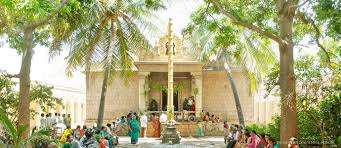Sri Gayathri Devi Temple
Sri Gayathri Devi Temple
From it's genesis in the year 1399 to the Independence of India in 1947, the Wodeyar Dynasty built the glorious kingdom of Mysore. The Wodeyars progressive-administration saw Mysore emerge as a prosperous state and one of the important centers of art and culture in India. The Wodeyars were not only accomplished exponents of the fine arts, they were enthusiastic patrons as well, and their legacies continue to influence music and art even today.
The last Maharaja of Mysore,Sri Jayachamaraja Wodeyar was an ardent devotee of Sri Gayathri Devi. He named his eldest daughter (b.1946) after the Goddess. In 1951 he initiated the construction of Sri Gayathri Devi templewithin the Mysore palace fort.
The legendary sculptor Shilpa Siddanthi Sri Siddalingaswamy who had worked on many sculptures at the Palace, entrusted his protege Sri B.Basavanna to work on the temple sculptures. The resulting awe-inspiring architecture and sculptures are a testament to Sri B. Basavanna's amazing skill, Sri Siddalingaswamy's immense experience and Sri Jayachamaraja Wodeyar's devotion.
Sri Gayathri Devi is depicted with five faces (Panchamukhi) representing the Pancha pranas -Prana, Apana, Vyana, Udana and Samana. These pranas consist of the Pancha tatwas namely Prithvi, Jala, Vayu, Agni and Aakasha (Earth, Water, Air, Fire and Sky). Sri Gayathri Devi protects these five life-forces (pranas) of those who chant the Gayathri Mantra. The three forms of Sri Gayathri Devi namely Sri Savithri, Sri Gayathri and Sri Saraswathi are depicted in the form of detailed sculptures at the temple.
The last Maharaja of Mysore,Sri Jayachamaraja Wodeyar was an ardent devotee of Sri Gayathri Devi. He named his eldest daughter (b.1946) after the Goddess. In 1951 he initiated the construction of Sri Gayathri Devi templewithin the Mysore palace fort.
The legendary sculptor Shilpa Siddanthi Sri Siddalingaswamy who had worked on many sculptures at the Palace, entrusted his protege Sri B.Basavanna to work on the temple sculptures. The resulting awe-inspiring architecture and sculptures are a testament to Sri B. Basavanna's amazing skill, Sri Siddalingaswamy's immense experience and Sri Jayachamaraja Wodeyar's devotion.
Sri Gayathri Devi is depicted with five faces (Panchamukhi) representing the Pancha pranas -Prana, Apana, Vyana, Udana and Samana. These pranas consist of the Pancha tatwas namely Prithvi, Jala, Vayu, Agni and Aakasha (Earth, Water, Air, Fire and Sky). Sri Gayathri Devi protects these five life-forces (pranas) of those who chant the Gayathri Mantra. The three forms of Sri Gayathri Devi namely Sri Savithri, Sri Gayathri and Sri Saraswathi are depicted in the form of detailed sculptures at the temple.

